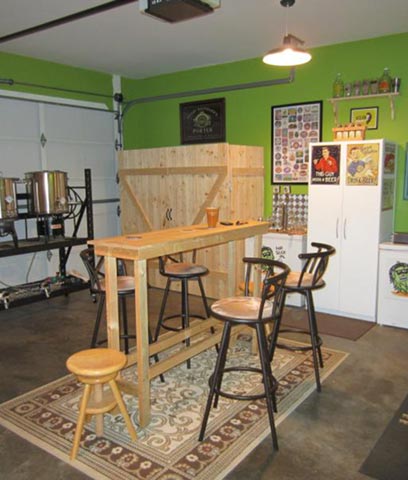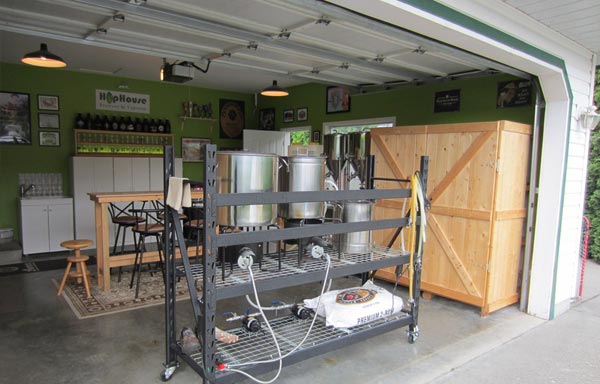
In 1995, Michael Smith visited a newly opened brewpub in Bellingham, Wa., where he tasted his first India pale ale. Smith was bitten by the beer bug, but locally brewed, flavorful beer was hard to come by in his home of British Columbia, so he began homebrewing.
Twenty years later, Smith is now a member of the Chilliwack Homebrewers club and has constructed an impressive home brewery and taproom in his garage. We caught up with Smith and asked him about his garage-turned-brew haven.
What made you decide to transform your garage into a home brewery and bar?
Initially, I was brewing 5-gallon batches on the kitchen stove, chilling the wort in the bathtub and fermenting with glass carboys in the corner of our bedroom. My wife was not happy with the occasional kettle boil overs, scratches to the bathtub and fermentation geysers on the carpet. With two kids and two cats under foot, the safety element was also a concern.
Seeing that I needed to take brewing out of the house, I set up in what was then a cluttered garage. This led to upgrades and additions to my collection of brewing equipment over time. Soon, the family car was spending less time parked in the garage. I would ask my wife not to park 4in the garage during active fermentation periods because the heat given off from the engine would raise the fermentation temperature of the brew.
Once I added the keezer with beer tower and started pouring pints from kegs, more time was spent in that cluttered garage enjoying my ales on tap. It was becoming a Saturday afternoon meeting place with our friends. I called us the Saturday Afternoon Pint Club. I began to think that with help from my good friend Bart, we could transform this garage into our own brewery and taproom. A scaled down version of the kind of place we enjoy visiting and I dreamed of owning. Now it’s no longer a garage, it’s the HopHouse Brewery and Taproom. And no car shall park in there again!

Can you tell us a bit about your brewing system and fermentation setup?
My brew stand used to be a metal shelving unit that was donated to the project by Bart. He cut the shelving unit down to two levels and added wheels creating the platform for a very functional single tier system.
My single tier brew system consists of three stainless steel kettles that I use for the mash/lauter tun, hot liquor tank and a 19-gallon boil kettle. The mash lauter tun has a false bottom and an added port at the top for sparging. The hot liquor tank includes a stainless steel 25’ HERMS coil. The boil kettle has a port with compression fitting and arm for recirculating the wort after boiling. This system uses two chugger pumps to efficiently transfer the liquid and to sparge. I use a Blichmann Hop Rocket and plate chiller inline to the fermenter.
I initially purchased two Mini Brew 7.5 gallon fermenters and then added two 14.5 gallon stainless steel Stout Tanks conical fermenters. Using Ranco Digital Two-Stage Temperature Controllers with FermWrap heaters, I can control fermentation temperature in the winter.
I set up a sanitation station by my fermentation table that uses a diaphragm pump to sanitize equipment and hoses with Star San.
What are some other cool features of your bar?
To house some of my brewing equipment and supplies, Bart built two beautiful wood cabinets with barn style doors. He also built a stand up bar table and the bench that holds my fermenters. He completed the fermentation bench with a faux stainless steel table top and sides for a nice clean appearance.
Also, I have been collecting beer glasses and growlers over the years and decided to build a shelving unit to display them using a lighting feature. I added beer themed artwork and a collection of tap handles to display on the walls. For something to do other than just drink beer and eat, we added a dart board and dart mat for lively Saturday afternoon matches. Last year I decided that the plain old white walls had to go. I painted the HopHouse hop green. Perfect.

How long did it take for this home brewery and bar to come to become reality?
It took about one year to complete the HopHouse in its current form. It started with the equipment purchase and brewery build first. That was the most expensive part. Once that was in place and I was set up for brewing larger batches, I was able to focus on the taproom setup which didn’t take long and was much less expensive. Thank goodness for Bart and his builder skills. What would have taken me a long time, he was able to complete quickly. Bart’s wife Tammy is an artist and designed the logo for my house IPA and of course my wife Elaine put up with all my obsessing during this time. She’s also my best beer critic.
So…what’s on tap?!
I currently have two IPAs on tap and a Belgian IPA fermenting with Yeast Bay Wallonian Farmhouse yeast. The IPAs are double dry hopped. Once in the fermenter with pellets and again in the keg with whole leaf. I like my hops.


Share Post